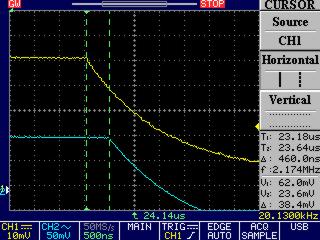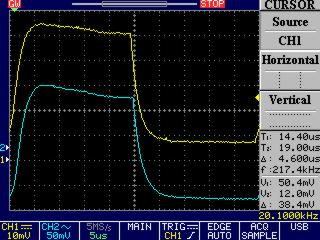- Computers are NOT needed for lab this week. Only one laptop is needed for the hallway experiment, and it's already connected
- Jeff will probably do this, but here is the sign to print and place on window of stairwell door, next to apparatus
- The hallway experiment is a pain in the ass for me to set up, but the students enjoy doing it!
- The computer will be logged into an Admin lab account, and will run FreeView to mirror and print the oscilloscope screen. Notes about Freeview and its associated issues are below
- Note: connection problems arise when the computer display goes to sleep. It's best if the computer is logged into the account just before it is used by the first group
- One shared apparatus in the hallway is used to measure c. Bring out one or two groups at a time (I take about 15 minutes per group, so it can take ~2 hours to get through 8 groups!)
- The other groups will work on the coordinate transformation exercise in the lab. Here are my solutions
- A demonstration corner cube is on the instructor's bench. Encourage students to look at it and note the following:
- When staring at the cube, your dominant eye will appear at the center intersection of the three mirrors in the cube
- Swivel the cube around a little, noting that your eye remains centered
- Close the eye that is at the center; immediately the other eye will be at the center
- Open both eyes again, and feel your brain melt as it tries to decide which eye will be at the center. The dominant eye will soon win out
- A square wave is used to drive the laser, which gives a more distinct drop-off in the signal, making cursor positioning easier
- Before each group comes out, reset the position of the cursors on the oscilloscope, hide the cursors and set the sweep to around 5 μs to show the entire square wave, as shown in Figure 1 below
- Explain how the apparatus works; an identical Fresnel lens is sitting on the optical bench, so you can show students how it works. Next show students the basic operation of the scope, and have them adjust the cursors according to each signal (steps below). Make sure the power switch for each detector is turned on
- Typical results are within a few percent of c
- Steps for students collecting their data:
- Show students the oscilloscope screen display, with the signal from CH1 (close detector, yellow signal) and CH2 (far detector, blue). Point out that the horizontal axis is time
- Start with the sweep around 5 μs or more to display the square wave
- Press the Run/Stop button to freeze the display (keep your arm out of the laser path). Make sure you have a clean signal, or try again as needed to reduce the amount of noise
- Turn off the function generator; this will turn off the laser and prevent the laser from overheating
- Change the sweep (Time/Div knob) to around 500 ns, which will 'zoom in' on the section of the curves where the function drops off
- Tell students to press the F2 button, which will make both cursors visible. Note that the symbol in the Cursor-Horizontal on-screen menu has two solid vertical lines
- Press F2 again and note that the symbol in the Cursor menu has changed so that the left line is solid and the right line is dashed. Turn the Variable knob to move the left cursor until it is at the drop-off point for the CH1 signal (yellow)
- Press F2 again and turn the Variable knob to move the right cursor until it is at the drop-off point for the CH2 signal (blue)
- Read the Δ (time difference) value from the screen
- The "sweet spot" is 460 ns. Feel free to encourage students to position the cursors to get this value, so that their measurement is within 1% of c
- The laptop will mirror the image of the oscilloscope. Print one copy of the screen image for each group as follows: choose File, then Print/Save. Then click the Print button, and one copy will print to the default printer (Bewkes 231). Click the Close button to dismiss the print dialog box
- Students will then measure D with the trundle wheel. We now have a trundle wheel that has a gauge that reads out the distance, so students don't have to count 'clicks' every meter. They will also check the measurement on the way back and then go the extra distance to detector 2
- Note that the trundle wheel should only be used while moving forward. If you pull it backwards, the counter will rewind itself!
- Students will typically measure 68±0.5 m (laser to corner cube) and 69±0.5 m (corner cube to Detector 2). Have them remeasure if they're significantly different. They should then return to the lab and send out the next group
- While waiting for the next group, reset the cursors on the oscilloscope:
- Press F2 until both cursors are visible, and move them to the right, away from the measurement positions. You should also change the separation of the cursors. Again press F2 until the cursors are hidden, and press the Run/Stop button
- You should also reset the sweep so that they can see the entire wave, as in Figure 1 below
- When all groups have finished, be sure to turn off the switch for both detectors! The batteries will drain if the switch is left on
- Show students the oscilloscope screen display, with the signal from CH1 (close detector, yellow signal) and CH2 (far detector, blue). Point out that the horizontal axis is time
- Freeview is an ancient program, ca. 2009 - it is a small miracle if it runs each year. Jeff will install it on the computer connected to the oscilloscope. If it doesn't work, just have students take a photo of the oscilloscope screen with their smartphones.
- Issues with Freeview:
- Double-click the shortcut on the desktoop to launch. You will be asked to search the Microsoft store for an app. Decline the search and then Freeview launches fine. Duh.
- In Freeview, select the Connect menu, then choose... (Jeff, update this!)
- Click the Print button once, and it immediatly sends one copy of the screenshot to the default printer in the lab (Bewkes 231)
- Issues with Freeview:
- Screen shots:
|
 Figure 2: Sweep changed to 500 ns and centered on dropoff of each curve. Δt = 460 ns |
